مخطط DSPL
تنظيم صفحاتك في مجموعات
يمكنك حفظ المحتوى وتصنيفه حسب إعداداتك المفضّلة.
توثّق هذه الصفحة وصفحاتها الفرعية المرتبطة مخطط DSPL XML.
هذه المادة مخصّصة للمستخدمين المتقدّمين الذين يريدون التعرّف على
التفاصيل المنخفضة المستوى للغة؛ لمعظم المستخدمين، يجب أن يكون المحتوى
في
دليل المطوِّر يجب أن يكون كافيًا للإنشاء والتعديل.
مجموعات بيانات DSPL.
يتوفّر مخطط XML الكامل للتنزيل بتنسيق XSD.
في
موقع رمز DSPL الإلكتروني.
العنصر: dspl
| مساحة الاسم |
http://schemas.google.com/dspl/2010 |
| التعليقات التوضيحية |
تصف مواصفات DSPL مجموعة بيانات. مجموعة البيانات هي
يتم تحديدها من خلال مساحة الاسم. تتألف مجموعة البيانات مما يلي:
العناصر: - الجداول: بيانات المفاهيم والشرائح المحددة في
مجموعة البيانات - المفاهيم: التعريفات والبُنى التي يحددها المستخدم في
مجموعة البيانات - الشرائح: مجموعات للأبعاد والمقاييس الموجودة في
مجموعة البيانات - الموضوعات: التسميات الهرمية المستخدمة لتنظيم مفاهيم
مجموعة البيانات |
| المخطط البياني |
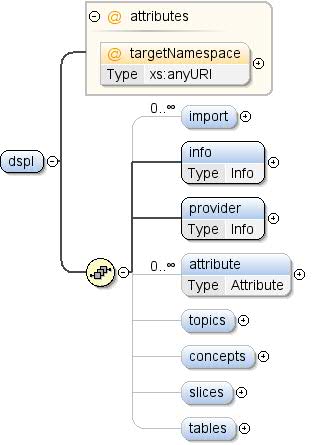 |
| أماكن إقامة |
|
| الطراز |
Import* وinfo وprovider
السمة* , الموضوعات{0,1} , المفاهيم{0,1} , الشرائح{0,1} , الجداول{0,1} |
| أطفال |
السمة والمفاهيم والاستيراد
info وprovider وslices
الجداول، المواضيع |
| آلة افتراضية |
<dspl targetNamespace="">
<import location="" namespace="">{0,unbounded}</import>
<info>{1,1}</info>
<provider>{1,1}</provider>
<attribute concept="" id="">{0,unbounded}</attribute>
<topics>{0,1}</topics>
<concepts>{0,1}</concepts>
<slices>{0,1}</slices>
<tables>{0,1}</tables>
</dspl>
|
| السمات |
| QName |
النوع |
ثابت |
تلقائي |
استخدام |
تعليق توضيحي |
| targetNamespace |
xs:anyURI |
|
|
اختياري |
قد توفر كل مجموعة بيانات مساحة اسم مستهدَفة. الهدف
مساحة الاسم هي معرف موارد منتظم (URI) يُعرّف مجموعة البيانات بشكل فريد. لمزيد من المعلومات،
لمزيد من المعلومات حول استخدام مساحات الاسم في XML، راجع:
http://www.w3.org/TR/REC-xml-names/ في حال عدم توفّر targetNamespace
فسيتم إنشاء مساحة اسم عندما يتم
التي تم استيرادها |
|
| المصدر |
<xs:element name="dspl">
<xs:annotation>
<xs:documentation>A DSPL specification describes a dataset. A dataset is
identified by its namespace. A dataset is comprised of the
following elements:
- Tables: Data for the concepts and slices defined in the
dataset
- Concepts: User-specified definitions and structures used in
the dataset
- Slices: Combinations of dimensions and metrics present in
the dataset
- Topics: Hierarchical labels used to organise the concepts of
the dataset</xs:documentation>
</xs:annotation>
<xs:complexType>
<xs:sequence>
<xs:element name="import" minOccurs="0" maxOccurs="unbounded">
<xs:annotation>
<xs:documentation>Import directive for external datasets -- modeled after
the XML Schema import directive. In order to use
elements defined in an external dataset, the external
dataset must be referenced using an import directive.</xs:documentation>
</xs:annotation>
<xs:complexType>
<xs:attribute name="namespace" use="required">
<xs:annotation>
<xs:documentation>The namespace of the imported dataset, specified as
a URI. A prefix must be associated with this
namespace before its contents can be referenced. See
[XML Namespaces] for more information about the use
of namespaces and prefixes in XML.</xs:documentation>
</xs:annotation>
</xs:attribute>
<xs:attribute name="location" use="optional">
<xs:annotation>
<xs:documentation>An optional location where the definition of the
imported dataset can be found, specified as a
URL. If the location is omitted, the system
processing this DSPL dataset must already know the
imported dataset.
Implementation note: The Google dataset importer
ignores the location attribute. Any imported dataset
must be known by the Google importer beforehand.</xs:documentation>
</xs:annotation>
</xs:attribute>
</xs:complexType>
</xs:element>
<xs:element name="info" type="Info" minOccurs="1">
<xs:annotation>
<xs:documentation>General information about the dataset.</xs:documentation>
</xs:annotation>
</xs:element>
<xs:element name="provider" type="Info">
<xs:annotation>
<xs:documentation>General information about the dataset provider.</xs:documentation>
</xs:annotation>
</xs:element>
<xs:element name="attribute" type="Attribute" minOccurs="0" maxOccurs="unbounded">
<xs:annotation>
<xs:documentation>Attribute associated with the dataset.</xs:documentation>
</xs:annotation>
</xs:element>
<xs:element name="topics" minOccurs="0">
<xs:annotation>
<xs:documentation>A hierarchy of topics used to organize the contents of
the dataset. The order in which topics are given is
meaningful and should be respected by visualizations
that displays these topics.</xs:documentation>
</xs:annotation>
<xs:complexType>
<xs:sequence>
<xs:element name="topic" type="Topic" maxOccurs="unbounded"/>
</xs:sequence>
</xs:complexType>
</xs:element>
<xs:element name="concepts" minOccurs="0">
<xs:annotation>
<xs:documentation>A list of concepts defined in this dataset.</xs:documentation>
</xs:annotation>
<xs:complexType>
<xs:sequence>
<xs:element name="concept" type="Concept" maxOccurs="unbounded"/>
</xs:sequence>
</xs:complexType>
</xs:element>
<xs:element name="slices" minOccurs="0">
<xs:annotation>
<xs:documentation>A list of slices defined in this dataset.</xs:documentation>
</xs:annotation>
<xs:complexType>
<xs:sequence>
<xs:element name="slice" type="Slice" maxOccurs="unbounded"/>
</xs:sequence>
</xs:complexType>
</xs:element>
<xs:element name="tables" minOccurs="0">
<xs:annotation>
<xs:documentation>A list of tables defined in this dataset.</xs:documentation>
</xs:annotation>
<xs:complexType>
<xs:sequence>
<xs:element name="table" type="Table" maxOccurs="unbounded"/>
</xs:sequence>
</xs:complexType>
</xs:element>
</xs:sequence>
<xs:attribute name="targetNamespace" type="xs:anyURI" use="optional">
<xs:annotation>
<xs:documentation>Each dataset may provide a target namespace. The
target namespace is a URI that uniquely identifies the
dataset. For more information about the use of namespaces in XML,
see:
http://www.w3.org/TR/REC-xml-names/
If no targetNamespace is provided, then a namespace will be
generated when the dataset is imported.</xs:documentation>
</xs:annotation>
</xs:attribute>
</xs:complexType>
</xs:element>
|
العنصر: dspl / استيراد
| مساحة الاسم |
http://schemas.google.com/dspl/2010 |
| التعليقات التوضيحية |
توجيه الاستيراد لمجموعات البيانات الخارجية -- المصممة على طراز XML
توجيه استيراد المخطط من أجل استخدام العناصر المحددة في مخطط خارجي
يجب الإشارة إلى مجموعة البيانات الخارجية باستخدام
. |
| المخطط البياني |
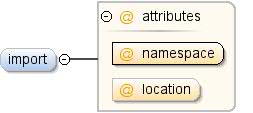 |
| أماكن إقامة |
| المحتوى: |
معقد |
| الحد الأدنى للتكرار: |
0 |
| maxOccurs: |
غير محدود |
|
| السمات |
| QName |
النوع |
ثابت |
تلقائي |
استخدام |
تعليق توضيحي |
| الموقع الجغرافي |
|
|
|
اختياري |
موقع اختياري يكون فيه تعريف ملفات تعريف الارتباط التي تم استيرادها
مجموعة البيانات المحددة كعنوان URL. إذا كان الموقع
إلا أن النظام الذي يعالج مجموعة بيانات DSPL هذه يجب أن يعرف
مجموعة البيانات المستوردة. ملاحظة حول التنفيذ: مجموعة بيانات Google
يتجاهل المستورد سمة location. يجب أن تكون أي مجموعة بيانات مستوردة
أن يكون مستوردًا في Google معروفًا مسبقًا. |
| مساحة الاسم |
|
|
|
مطلوب |
مساحة الاسم لمجموعة البيانات التي تم استيرادها، والمحددة
معرّف الموارد المنتظم (URI). يجب ربط البادئة بمساحة الاسم هذه قبل
يمكن الرجوع إليها. يمكنك الاطّلاع على [XML Namespaces] للحصول على مزيد من المعلومات.
معلومات حول استخدام مساحات الاسم والبادئات في
XML. |
|
| المصدر |
<xs:element name="import" minOccurs="0" maxOccurs="unbounded">
<xs:annotation>
<xs:documentation>Import directive for external datasets -- modeled after
the XML Schema import directive. In order to use
elements defined in an external dataset, the external
dataset must be referenced using an import directive.</xs:documentation>
</xs:annotation>
<xs:complexType>
<xs:attribute name="namespace" use="required">
<xs:annotation>
<xs:documentation>The namespace of the imported dataset, specified as
a URI. A prefix must be associated with this
namespace before its contents can be referenced. See
[XML Namespaces] for more information about the use
of namespaces and prefixes in XML.</xs:documentation>
</xs:annotation>
</xs:attribute>
<xs:attribute name="location" use="optional">
<xs:annotation>
<xs:documentation>An optional location where the definition of the
imported dataset can be found, specified as a
URL. If the location is omitted, the system
processing this DSPL dataset must already know the
imported dataset.
Implementation note: The Google dataset importer
ignores the location attribute. Any imported dataset
must be known by the Google importer beforehand.</xs:documentation>
</xs:annotation>
</xs:attribute>
</xs:complexType>
</xs:element>
|
العنصر: dspl / info
| مساحة الاسم |
http://schemas.google.com/dspl/2010 |
| التعليقات التوضيحية |
معلومات عامة عن مجموعة البيانات: |
| المخطط البياني |
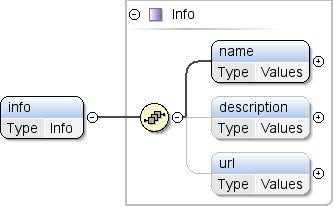 |
| النوع |
معلومات |
| أماكن إقامة |
| المحتوى: |
معقد |
| الحد الأدنى للتكرار: |
1 |
|
| الطراز |
name ، description{0,1} ، url{0,1} |
| أطفال |
description وname وurl |
| آلة افتراضية |
<info>
<name>{1,1}</name>
<description>{0,1}</description>
<url>{0,1}</url>
</info>
|
| المصدر |
<xs:element name="info" type="Info" minOccurs="1">
<xs:annotation>
<xs:documentation>General information about the dataset.</xs:documentation>
</xs:annotation>
</xs:element>
|
العنصر: dspl / provider
| مساحة الاسم |
http://schemas.google.com/dspl/2010 |
| التعليقات التوضيحية |
معلومات عامة عن موفِّر مجموعة البيانات |
| المخطط البياني |
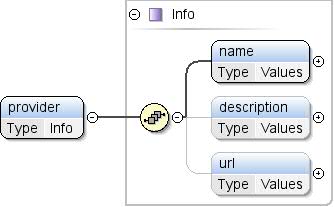 |
| النوع |
معلومات |
| أماكن إقامة |
|
| الطراز |
name ، description{0,1} ، url{0,1} |
| أطفال |
description وname وurl |
| آلة افتراضية |
<provider>
<name>{1,1}</name>
<description>{0,1}</description>
<url>{0,1}</url>
</provider>
|
| المصدر |
<xs:element name="provider" type="Info">
<xs:annotation>
<xs:documentation>General information about the dataset provider.</xs:documentation>
</xs:annotation>
</xs:element>
|
العنصر: dspl / السمة
| مساحة الاسم |
http://schemas.google.com/dspl/2010 |
| التعليقات التوضيحية |
السمة المرتبطة بمجموعة البيانات: |
| المخطط البياني |
 |
| النوع |
السمة |
| أماكن إقامة |
| المحتوى: |
معقد |
| الحد الأدنى للتكرار: |
0 |
| maxOccurs: |
غير محدود |
|
| الطراز |
info{0,1} , type{0,1} , (القيمة*
| conceptValue{0,1}) |
| أطفال |
conceptValue وinfo وtype
القيمة |
| آلة افتراضية |
<attribute concept="" id="">
<info>{0,1}</info>
<type format="" ref="">{0,1}</type>
</attribute>
|
| السمات |
| QName |
النوع |
ثابت |
تلقائي |
استخدام |
تعليق توضيحي |
| مفهوم |
xs:QName |
|
|
اختياري |
إشارة إلى مفهوم يتوافق مع القيم
للسمة. إذا كانت السمة تحدد نوعًا، يتم تحديد النوع
يجب أن يتطابق مع نوع المفهوم المُشار إليه. مرجع إلى
المفهوم الخارجي يجب أن يكون شكل
"prefix:other_concept_id"، حيث "prefix" CANNOT TRANSLATE
البادئة المستخدمة في مساحة الاسم لمجموعة البيانات الخارجية (راجع XML
ومساحات الاسم). |
| المعرِّف |
LocalId |
|
|
اختياري |
معرّف سمة المفهوم: يجب أن يكون هذا المعرف
فريدة ضمن المفهوم (على مستوى السمات والخصائص). تشير رسالة الأشكال البيانية
يمكن حذف المعرّف إذا تم تحديد سمة المفهوم. في ذلك،
الحالة، المعرف هو عبارة عن ترابط يتم إنشاؤه بقيمة الاسم المحلي
المفهوم المشار إليه. على سبيل المثال، <attribute
concept="unit:currency"/> تعادل
<attribute id="currency"
concept="unit:currency"/> |
|
| المصدر |
<xs:element name="attribute" type="Attribute" minOccurs="0" maxOccurs="unbounded">
<xs:annotation>
<xs:documentation>Attribute associated with the dataset.</xs:documentation>
</xs:annotation>
</xs:element>
|
العنصر: dspl / Topics
| مساحة الاسم |
http://schemas.google.com/dspl/2010 |
| التعليقات التوضيحية |
تسلسل هرمي للمواضيع يُستخدم لتنظيم محتوى
مجموعة البيانات الأصلية. الترتيب الذي تعطى به المواضيع مهم ويجب
أيضًا من خلال العروض المرئية التي تعرض هذه المواضيع |
| المخطط البياني |
 |
| أماكن إقامة |
| المحتوى: |
معقد |
| الحد الأدنى للتكرار: |
0 |
|
| الطراز |
topic+ |
| أطفال |
الموضوع |
| آلة افتراضية |
<topics>
<topic id="" parentTopic="">{1,unbounded}</topic>
</topics>
|
| المصدر |
<xs:element name="topics" minOccurs="0">
<xs:annotation>
<xs:documentation>A hierarchy of topics used to organize the contents of
the dataset. The order in which topics are given is
meaningful and should be respected by visualizations
that displays these topics.</xs:documentation>
</xs:annotation>
<xs:complexType>
<xs:sequence>
<xs:element name="topic" type="Topic" maxOccurs="unbounded"/>
</xs:sequence>
</xs:complexType>
</xs:element>
|
| مساحة الاسم |
http://schemas.google.com/dspl/2010 |
| المخطط البياني |
 |
| النوع |
Topic |
| أماكن إقامة |
| المحتوى: |
معقد |
| maxOccurs: |
غير محدود |
|
| الطراز |
info ، topic* |
| أطفال |
info، topic |
| آلة افتراضية |
<topic id="" parentTopic="">
<info>{1,1}</info>
<topic id="" parentTopic="">{0,unbounded}</topic>
</topic>
|
| السمات |
| QName |
النوع |
ثابت |
تلقائي |
استخدام |
تعليق توضيحي |
| المعرِّف |
رقم التعريف |
|
|
مطلوب |
المعرف الفريد للموضوع في
مجموعة البيانات |
| parentTopic |
xs:QName |
|
|
اختياري |
معرّف الموضوع الرئيسي لهذا الموضوع، إذا كان متوفرًا.
لا يمكن تحديد parentTopic للمواضيع التي تم تضمينها داخل
مواضيع أخرى |
|
| المصدر |
<xs:element name="topic" type="Topic" maxOccurs="unbounded"/>
|
العنصر: dspl / المفاهيم
| مساحة الاسم |
http://schemas.google.com/dspl/2010 |
| التعليقات التوضيحية |
قائمة بالمفاهيم المحدّدة في مجموعة البيانات هذه |
| المخطط البياني |
 |
| أماكن إقامة |
| المحتوى: |
معقد |
| الحد الأدنى للتكرار: |
0 |
|
| الطراز |
مفهوم+ |
| أطفال |
مفهوم |
| آلة افتراضية |
<concepts>
<concept extends="" id="">{1,unbounded}</concept>
</concepts>
|
| المصدر |
<xs:element name="concepts" minOccurs="0">
<xs:annotation>
<xs:documentation>A list of concepts defined in this dataset.</xs:documentation>
</xs:annotation>
<xs:complexType>
<xs:sequence>
<xs:element name="concept" type="Concept" maxOccurs="unbounded"/>
</xs:sequence>
</xs:complexType>
</xs:element>
|
| مساحة الاسم |
http://schemas.google.com/dspl/2010 |
| المخطط البياني |
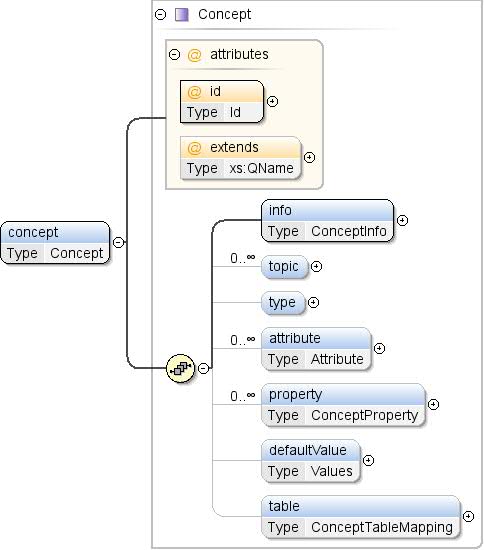 |
| النوع |
المفهوم |
| أماكن إقامة |
| المحتوى: |
معقد |
| maxOccurs: |
غير محدود |
|
| الطراز |
info ، topic* ، type{0,1} ،
attribute* , property* , defaultValue{0,1} , table{0,1} |
| أطفال |
السمة وdefaultValue وinfo
الموقع والجدول والموضوع
النوع |
| آلة افتراضية |
<concept extends="" id="">
<info>{1,1}</info>
<topic ref="">{0,unbounded}</topic>
<type ref="">{0,1}</type>
<attribute concept="" id="">{0,unbounded}</attribute>
<property concept="" id="" isMapping="false" isParent="false">{0,unbounded}</property>
<defaultValue>{0,1}</defaultValue>
<table ref="">{0,1}</table>
</concept>
|
| السمات |
| QName |
النوع |
ثابت |
تلقائي |
استخدام |
تعليق توضيحي |
| يمتد |
xs:QName |
|
|
اختياري |
المعرف الفريد لمفهوم أن هذا المفهوم
يمدّد. يمكن تعريف المفهوم المُشار إليه في مجموعة البيانات نفسها.
أو خارجيًا، أي في مجموعة بيانات أخرى. يشير هذا المصطلح إلى إشارة إلى
يجب أن يكون المفهوم بالصيغة "prefix:other_concept_id"،
حيث "بادئة" هي البادئة المستخدمة في مساحة الاسم
مجموعة البيانات الخارجية (راجِع مساحات أسماء XML). |
| المعرِّف |
رقم التعريف |
|
|
مطلوب |
المعرف الفريد للمفهوم، والذي يجب
فريدة عالميًا ضمن مجموعة البيانات |
|
| المصدر |
<xs:element name="concept" type="Concept" maxOccurs="unbounded"/>
|
العنصر: dspl / الشرائح
| مساحة الاسم |
http://schemas.google.com/dspl/2010 |
| التعليقات التوضيحية |
قائمة بالشرائح المحددة في مجموعة البيانات هذه. |
| المخطط البياني |
 |
| أماكن إقامة |
| المحتوى: |
معقد |
| الحد الأدنى للتكرار: |
0 |
|
| الطراز |
slice+ |
| أطفال |
شريحة |
| آلة افتراضية |
<slices>
<slice id="">{1,unbounded}</slice>
</slices>
|
| المصدر |
<xs:element name="slices" minOccurs="0">
<xs:annotation>
<xs:documentation>A list of slices defined in this dataset.</xs:documentation>
</xs:annotation>
<xs:complexType>
<xs:sequence>
<xs:element name="slice" type="Slice" maxOccurs="unbounded"/>
</xs:sequence>
</xs:complexType>
</xs:element>
|
| مساحة الاسم |
http://schemas.google.com/dspl/2010 |
| المخطط البياني |
 |
| النوع |
الشريحة |
| أماكن إقامة |
| المحتوى: |
معقد |
| maxOccurs: |
غير محدود |
|
| الطراز |
info{0,1} وdimension+ وmetric+
، جدول |
| أطفال |
السمة والمعلومات والمقياس
جدول |
| آلة افتراضية |
<slice id="">
<info>{0,1}</info>
<dimension concept="">{1,unbounded}</dimension>
<metric concept="">{1,unbounded}</metric>
<table ref="">{1,1}</table>
</slice>
|
| السمات |
| QName |
النوع |
ثابت |
تلقائي |
استخدام |
تعليق توضيحي |
| المعرِّف |
رقم التعريف |
|
|
مطلوب |
المعرّف الفريد للشريحة. |
|
| المصدر |
<xs:element name="slice" type="Slice" maxOccurs="unbounded"/>
|
العنصر: dspl / الجداول
| مساحة الاسم |
http://schemas.google.com/dspl/2010 |
| التعليقات التوضيحية |
قائمة الجداول المحدّدة في مجموعة البيانات هذه |
| المخطط البياني |
 |
| أماكن إقامة |
| المحتوى: |
معقد |
| الحد الأدنى للتكرار: |
0 |
|
| الطراز |
table+ |
| أطفال |
جدول |
| آلة افتراضية |
<tables>
<table id="">{1,unbounded}</table>
</tables>
|
| المصدر |
<xs:element name="tables" minOccurs="0">
<xs:annotation>
<xs:documentation>A list of tables defined in this dataset.</xs:documentation>
</xs:annotation>
<xs:complexType>
<xs:sequence>
<xs:element name="table" type="Table" maxOccurs="unbounded"/>
</xs:sequence>
</xs:complexType>
</xs:element>
|
| مساحة الاسم |
http://schemas.google.com/dspl/2010 |
| المخطط البياني |
 |
| النوع |
جدول |
| أماكن إقامة |
| المحتوى: |
معقد |
| maxOccurs: |
غير محدود |
|
| الطراز |
info{0,1} , column+ , data{0,1} |
| أطفال |
العمود، data، info |
| آلة افتراضية |
<table id="">
<info>{0,1}</info>
<column format="" id="" type="">{1,unbounded}</column>
<data>{0,1}</data>
</table>
|
| السمات |
| QName |
النوع |
ثابت |
تلقائي |
استخدام |
تعليق توضيحي |
| المعرِّف |
رقم التعريف |
|
|
مطلوب |
المعرّف الفريد للجدول في
مجموعة البيانات |
|
| المصدر |
<xs:element name="table" type="Table" maxOccurs="unbounded"/>
|
السمة: dspl / استيراد / @namespace
| مساحة الاسم |
لا توجد مساحة اسم |
| التعليقات التوضيحية |
مساحة الاسم لمجموعة البيانات التي تم استيرادها، والمحددة كمعرّف موارد منتظم (URI). حاسمة
يجب أن يتم ربط البادئة بمساحة الاسم هذه قبل التمكن من إدراج محتواها
المشار إليها. يمكنك الاطلاع على [XML Namespaces] للحصول على مزيد من المعلومات حول استخدام
ومساحات الاسم والبادئات في ملف XML. |
| أماكن إقامة |
|
| قيد الاستخدام بواسطة |
|
| المصدر |
<xs:attribute name="namespace" use="required">
<xs:annotation>
<xs:documentation>The namespace of the imported dataset, specified as
a URI. A prefix must be associated with this
namespace before its contents can be referenced. See
[XML Namespaces] for more information about the use
of namespaces and prefixes in XML.</xs:documentation>
</xs:annotation>
</xs:attribute>
|
| مساحة الاسم |
لا توجد مساحة اسم |
| التعليقات التوضيحية |
موقع اختياري يكون فيه تعريف ملفات تعريف الارتباط التي تم استيرادها
مجموعة البيانات المحددة كعنوان URL. في حال إسقاط الموقع، سيتم
لمعالجة مجموعة بيانات DSPL هذه يجب أن تعرف بالفعل
مجموعة البيانات الأصلية. ملاحظة بشأن التنفيذ: تتجاهل أداة استيراد مجموعة بيانات Google
السمة location. يجب أن تكون Google على علم بأي مجموعة بيانات تم استيرادها
المستورد مسبقًا |
| أماكن إقامة |
|
| قيد الاستخدام بواسطة |
|
| المصدر |
<xs:attribute name="location" use="optional">
<xs:annotation>
<xs:documentation>An optional location where the definition of the
imported dataset can be found, specified as a
URL. If the location is omitted, the system
processing this DSPL dataset must already know the
imported dataset.
Implementation note: The Google dataset importer
ignores the location attribute. Any imported dataset
must be known by the Google importer beforehand.</xs:documentation>
</xs:annotation>
</xs:attribute>
|
السمة: dspl / @targetNamespace
| مساحة الاسم |
لا توجد مساحة اسم |
| التعليقات التوضيحية |
قد توفر كل مجموعة بيانات مساحة اسم مستهدَفة. الهدف
مساحة الاسم هي معرف موارد منتظم (URI) يُعرّف مجموعة البيانات بشكل فريد. لمزيد من المعلومات،
لمزيد من المعلومات حول استخدام مساحات الاسم في XML، راجع:
http://www.w3.org/TR/REC-xml-names/ إذا لم يتم تقديم targetNamespace،
فسيتم إنشاء مساحة اسم عندما تكون مجموعة البيانات
التي تم استيرادها |
| النوع |
xs:anyURI |
| أماكن إقامة |
|
| قيد الاستخدام بواسطة |
|
| المصدر |
<xs:attribute name="targetNamespace" type="xs:anyURI" use="optional">
<xs:annotation>
<xs:documentation>Each dataset may provide a target namespace. The
target namespace is a URI that uniquely identifies the
dataset. For more information about the use of namespaces in XML,
see:
http://www.w3.org/TR/REC-xml-names/
If no targetNamespace is provided, then a namespace will be
generated when the dataset is imported.</xs:documentation>
</xs:annotation>
</xs:attribute>
|
تم إنشاؤه باستخدام
محرِّر XML oXygen:
إنّ محتوى هذه الصفحة مرخّص بموجب ترخيص Creative Commons Attribution 4.0 ما لم يُنصّ على خلاف ذلك، ونماذج الرموز مرخّصة بموجب ترخيص Apache 2.0. للاطّلاع على التفاصيل، يُرجى مراجعة سياسات موقع Google Developers. إنّ Java هي علامة تجارية مسجَّلة لشركة Oracle و/أو شركائها التابعين.
تاريخ التعديل الأخير: 2025-07-25 (حسب التوقيت العالمي المتفَّق عليه)
[null,null,["تاريخ التعديل الأخير: 2025-07-25 (حسب التوقيت العالمي المتفَّق عليه)"],[],["The DSPL XML schema defines a dataset's structure using key components: `tables`, `concepts`, `slices`, and `topics`. The root `dspl` element encapsulates the dataset, utilizing `import` to reference externals, `info` and `provider` for metadata, `attribute` for dataset attributes, and `topics` to hierarchically organize the concepts. `concepts`, `slices`, `tables` are for concept definition, slice definition, and data table, respectively. Each element like `import`, `info`, `provider`, `attribute`, `topic`, `concept`, `slice`, `table` uses specific attributes and child elements for configuration. Each element has a specific cardinality that is defined in the document.\n"]]












